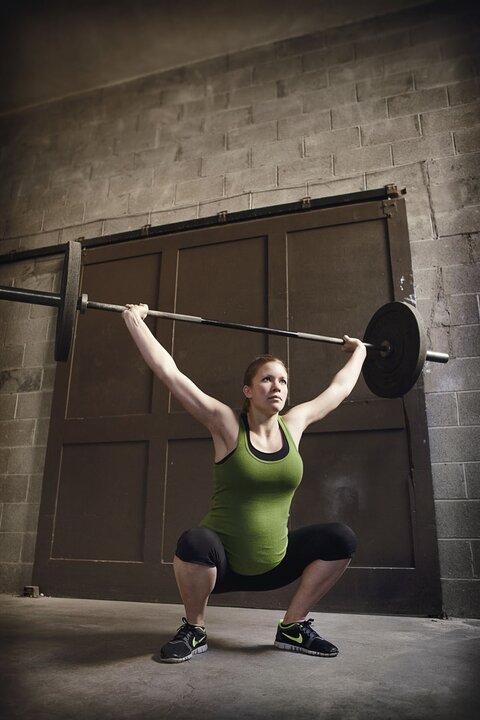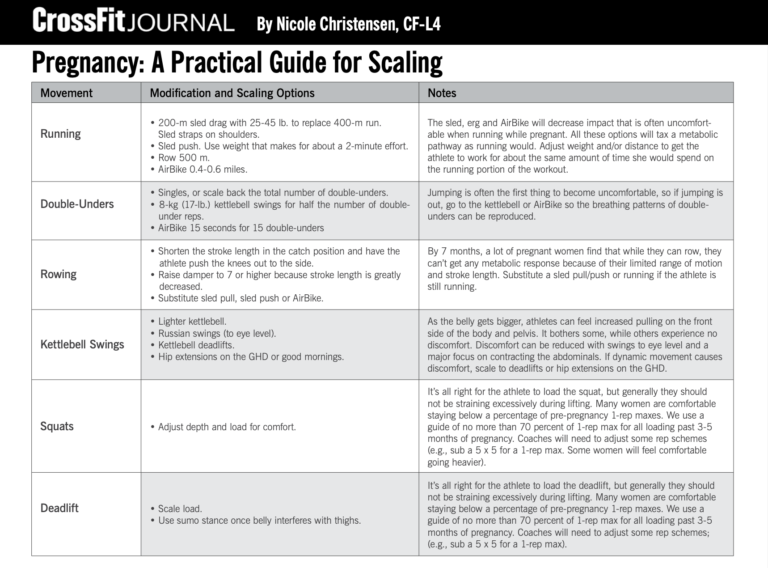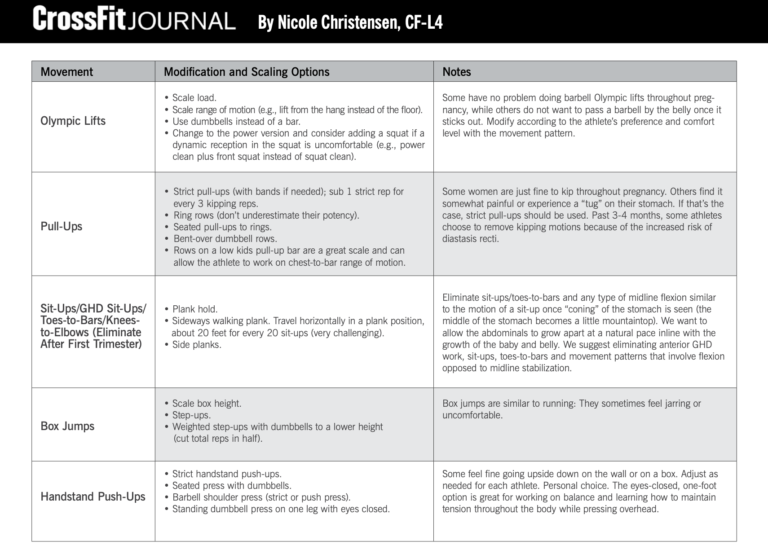The short answer is yes, women who are pregnant can safely train with CrossFit. Like with any exercise regimen, there are always safety considerations. With pregnant women, there are some specific things to consider: Have they done CrossFit before? Are they experiencing a normal or a high-risk pregnancy? Which movements and loads feel good? Which do not? How is their body changing as the pregnancy progresses and the baby develops?
In an article titled “CrossFit Training During Pregnancy and Motherhood: A New Scientific Frontier,” Dr. Cooker Perkins wrote, “The first guidelines about what women can and can’t do with respect to aerobic exercise during pregnancy were published in 1985. Because the guidelines were based on what science knew (and did not know), these guidelines were quite conservative.
“Now, over 25 years later, with a surfeit of research studies to glean from, the recommendations for aerobic exercise during pregnancy have advanced quite a bit. To be brief, they essentially changed from ‘guidelines’ to ‘recommendations’ while they modified, expanded and clarified the details along the way. The terminology has changed from ‘women can do’ to ‘women should do’ aerobic exercise.”
While this is encouraging, when it comes to CrossFit workouts, the training goes far beyond aerobic conditioning. Some days we lift heavy; some days we lift light. Sometimes we run and jump, sometimes bike or row. We deadlift, clean, and squat. We use barbells, dumbbells, medicine balls, kettlebells, slam balls, gymnastics rings, boxes, pull-up bars, jump ropes, sleds, our own bodies — and anything and everything in between. Some workouts are long and steady; others are short and intense. While there is a lot to navigate for a pregnant athlete doing CrossFit, one thing is clear: the benefits abound.
What Are the Benefits of Doing CrossFit While Pregnant?

It’s no secret that regular exercise and sound nutrition are beneficial to the human body. Those who have a consistent exercise routine report higher energy levels, less incidence of depression, improved mood, fewer issues with weight control, and better health outcomes in general whether measured by routine blood work or propensity for illness. Specific to pregnancy, regular exercise reduces the risk of gestational diabetes, hypertension and preeclampsia, as well as improves cardiovascular health and reduces the likelihood of excessive weight gain.
If CrossFit is a pregnant woman’s training regimen, a whole host of other benefits come into the mix including having a supportive social network and a community that holds them accountable to healthy habits. So would all these benefits just disappear when a woman becomes pregnant? Of course not.
In addition to the cardiovascular benefits that come from aerobic exercise, pregnant women who do CrossFit can also look forward to maintaining strength and flexibility through their pregnancies, which is helpful for labor and delivery as well as the postpartum period. Continuing to practice functional movements and range of motion in things like squats, lunges, and presses, will set an expectant mother up for a healthy body during and beyond pregnancy.
What Are the Risks of Doing CrossFit While Pregnant?
As with any exercise program, there are risks involved. A pregnant woman doing CrossFit may take into account specific risks that could increase during pregnancy. One risk to be aware of is balance issues. As a pregnant belly grows, a woman’s center of mass changes and she may easily be thrown off balance. Common CrossFit movements can be modified to take this risk into account: box jumps can turn into step-ups, squat cleans can turn into front squats, and running can be replaced with rowing or biking.
Falling is another common concern. Mitigating any risk of falling or impact with the stomach will ensure safety when doing CrossFit while pregnant. To lessen this risk, pregnant women may stop doing certain movements like rope climbs, pull-ups, running, or box jumps.
The outdated heart-rate recommendations are often referenced when talking about CrossFit and pregnancy — doctors used to recommend pregnant women keep their heart rates at or below 140 BPM. Thankfully, the American College of Obstetricians and Gynecologists (ACOG) debunked this myth a long time ago.
Since heart rate varies for every individual, the general recommendations are now focused on staying consistent with whatever kind of exercise you were doing before you got pregnant. Heart-rate variability — a measure in the variation of time between each heartbeat — has actually been proven a helpful tool to inform when a woman is the most fertile and when to dial up and dial back exercise during pregnancy.
Diastasis recti — a gap between the left and right side of the abdominals in pregnant or postpartum women — is another common concern. This is a natural and normal occurrence during pregnancy and most women experience some degree of abdominal separation as connective tissue stretches and thins to allow the uterus to expand and the baby to grow — regardless of whether the mother exercises. If a woman is choosing to exercise during pregnancy, there are some precautions to take to ensure the diastasis recti does not get exacerbated.
For some, kipping will contribute to greater potential for diastasis recti after childbirth because the movement can force muscle fibers beyond their current length. Women may stop kipping movement patterns at around three to four months to mitigate the risk of worsening their diastasis recti. Additionally, any movement where a “coning” of the abdomen is visible can be avoided to further mitigate risk. A qualified CrossFit coach can help you watch for any concerning signs (coning) and provide modifications and alternatives for workouts and movements.
Potentially contributing to additional risk, a pregnant body undergoes massive hormonal shifts throughout pregnancy that should be considered when doing CrossFit. We’ll address this more in the modifications section below.
If any one movement causes discomfort for a pregnant woman, that movement should be modified or replaced with a movement that does not cause discomfort.
Can I Start CrossFit for the First Time During Pregnancy?
Absolutely! But you will want to train with a credentialed coach who has experience or knowledge around coaching pregnant women. In CrossFit, new athletes always start with the basics so your ease into this new training may be even more gradual than the new CrossFit athlete who is not pregnant. Learning how to squat properly (one of CrossFit’s nine foundational movements and one of the first you’ll learn) will no doubt prove beneficial during your pregnancy, labor and delivery, and for the rest of your life.
How Should I Modify CrossFit Workouts During Pregnancy?
The easy answer here is listen to your body. If you’re an experienced CrossFit athlete, listen to your body. If you’re brand new, the same advice applies. Some women feel comfortable clean-and-jerking their way through the whole nine months, while others opt for lighter weights and less impact very early on.
Work within a pain-free range of motion to preserve the intended stimulus and movement patterns whenever you can.
According to Certified CrossFit Coach Jeremy Gordon, “CrossFit workouts are scaled to preserve the intended stimuli despite athlete limitations such as experience, injury, illness or range of motion. A properly scaled workout safely maximizes relative intensity (load, speed, range of motion) to continue developing increased work capacity despite limitations.”
The same guidelines apply for pregnant women but with some additional considerations, including the many hormonal shifts that a pregnant woman will experience.
In early pregnancy, the hormone progesterone and the physical shifts as pregnancy progresses can lead to shortness of breath, a decrease in blood pressure, and an increased total blood volume that varies from 20% to 100% above prepregnancy levels, usually close to 45%, which can sometimes lead to dizziness. Scaling the intensity level, especially in the early weeks, is appropriate here.
Relaxin, a hormone that relaxes the ligaments in the pelvis in preparation for a growing body, labor, and delivery, will create changes in an athlete’s ability to maintain tension under load, increasing risk for hyperextension and potentially leading to injury if not acknowledged and addressed accordingly.

Taking the squat, for example, pregnant women often begin bottoming out at the bottom of their squat due to relaxin making it difficult to stabilize or maintain tension. If a pregnant athlete can initiate the descent of her squat with control but then plummets to the bottom with a drastic increase in speed, she’s lost some degree of control over her body. Moving with intention, and possibly reducing the load or complexity of the movement is the remedy here. Paying close attention to range of motion in each movement is helpful. Maintain integrity in each workout, focusing on deliberate and sound movement.
As an expectant mother’s belly grows, proper movement patterns for certain movements will be hindered — it’s hard to keep the bar close in a clean, for example, when you’ve got a protruding belly to work around. Some athletes will also find it difficult or painful to pull from the ground in deadlifts and Olympic lifts. When things like bar path start to become an issue, your coach can recommend alternatives like using dumbbells instead of a barbell or scrapping the movement all together for something else. If an athlete is unable to achieve or maintain a stable midline in the starting position of the lift, or experiences pain in pulling from the ground, consider raising the bar off the floor, or replacing these movements with Russian kettlebell swings, sumo deadlifts, or other variations that reduce the demands of the starting position.

You can find a practical guide to scaling CrossFit movements here that can help you as you navigate CrossFit during pregnancy. Continue to work with your doctor at regular check-ups and rely on your credentialed CrossFit coach to help keep you safe and fit throughout your pregnancy. We have no doubt you’ll be happy you stayed active and healthy through a very physically taxing time!